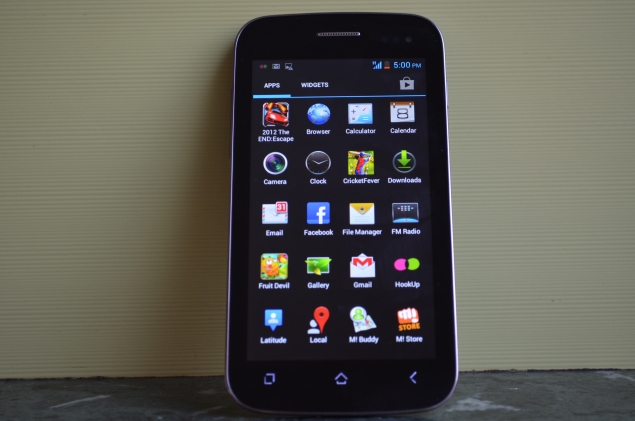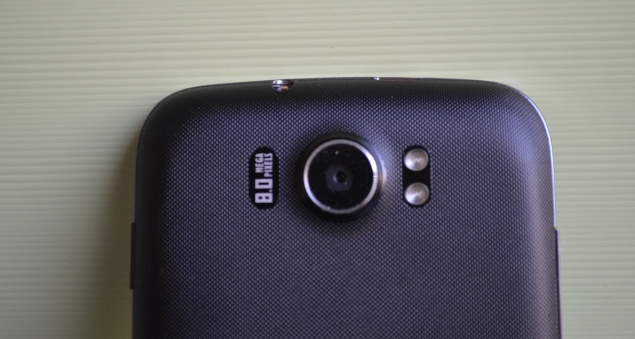
With big screen phones, popularly known as phablets, gaining prominence, and the increasing demand for budget alternatives, Micromax decided to upgrade its Canvas line-up, within two months of launching its first 5-inch phone, the A100. The successor to the A100, the A110 or Canvas 2 features a Dual Core processor, an IPS panel, and an upgraded 8-megapixel camera. Here's our review of the device.
Hardware
The front of the phone looks strikingly similar to the Samsung Galaxy S III and the Note II, except for the absence of a physical home button. The chrome speaker grill, front camera and sensors are positioned similar to that of the Note 2. There are markings for three capacitive touch buttons below the display. There's no Micromax branding on the front of the phone. There's a chrome trim around the phone that was a little too shiny for our liking. On the right side, there's a big power key, while the volume rocker sits on the left hand side. Both these keys also sport a chrome finish, but kind of lack refinement, in our opinion. The Micro-USB port and the 3.5mm audio ports sit on the top of the phone. The back cover is made of plastic and has a matte finish. The material used feels durable, and offers a good grip. The camera lens, however, protrudes out towards the top, and feels awkward. There's a dual LED flash besides the camera. The back also sports Micromax branding and a speaker.
In terms of hardware, the device is powered by a 1GHz dual-core processor with 512MB RAM, and has 4GB internal storage expandable up to 32GB with microSD card.

The Micromax A110 is a dual-SIM smartphone and supports GSM SIM card in both the slots. The SIM Card slots and a slot for the micro SD card hide behind the back cover just above the battery slot. Unfortunately, the SIM cards and the Micro SD cards are not hot-swappable and you'll have to take the battery out if you want to replace either of them.
Display
The Micromax A110 comes with a 5-inch 262k colour capacitive touch screen with an IPS panel sporting a resolution of 480x854 pixels. We found the screen resolution to be pretty low for a device of this size, and the graphics and text appeared to be less sharp. The viewing angles looked good, and the under-sun visibility on the phone was decent, though we found the screen to be highly reflective.
Camera
The 8-megapixel autofocus shooter takes decent images in daylight, although we feel that colour reproduction could have been better. Also, we observed that pictures taken in low-light conditions and indoors (without the use of the LED flash) were a bit grainy. The dual-led flash fulfills its intended purpose. The quality of videos captured through the back camera was average. Overall, we feel that the phone's good for casual photography.

A daylight shot taken with the Micromax A110 Canvas 2
There is also a 0.3-megapixel front camera, which takes average pictures, and can be used for video conferencing. We wish the phone had a dedicated camera button to help click a quick picture.
Software/ Interface
The Micromax Canvas 2 runs Android 4.0.4 (Ice Cream Sandwich). Micromax has skinned some elements of the user interface, such as the app icons and the notification tray. The notification tray includes toggles for settings such as Wi-Fi, Brightness, Rotation, Bluetooth, GPS, Data and profiles (for alerts and other notifications). Similar to other ICS devices, there are five customisable home screens that can be filled with app shortcuts and widgets.

Micromax has also included some of its own apps including its own apps and content store, M! Store, and services store, M! Zone, in addition to its messaging app, HookUp, and friends locator app, M! Buddy and a few games (Fruit Devil, Cricket Fever). The handset also offers FM Radio.
The handset sports three capacitive buttons - a Menu key, Home button and a Back key. Long pressing the Home key opens the app-switcher for switching between open/previously accessed apps. To be honest, we find the menu button redundant. Perhaps, Micromax could allow users to use the menu button exclusively as the app-switcher, on the lines of newer HTC phones.Also, the phone could do with stock icons, and we're not sure why Micromax decided to skin them. We also noticed that Micromax's app store was offering apps such as Viber and Nimbuzz, which are otherwise free, as paid apps.We checked with Micromax and they informed that their app store offers ad-free versions of the apps.
During our use of the phone we noticed some minor lag, especially while playing games, but other than that, we'd rate our overall experience as above average. We expected a bit more from a phone that runs on a dual-core processor. We're not sure if the phone would get updated to Jelly Bean, which offers a smoother user experience compared to ICS.
Performance/ Battery Life
The phone is powered by a 1GHz dual-core processor that is a MediaTek chip, and has 512MB of RAM on board. We did not encounter any crashes while working on the phone and multitasking was comfortable. We did notice some lag while navigating through the menu, and while playing some games. We were not able to play 1020p HD video clips, and 720p clips also stuttered. The phone also doesn't support .avi videos natively, but that can be easily fixed by downloading third-party video players.
The phone comes with the native Android browser and renders all webpages well. The phone doesn't come with Adobe Flash. The speaker on the phone delivers good quality sound but volume levels are low. Also, since the speaker is located at the back, the volume levels further decrease when the phone lies on its back. The phone surprisingly doesn't include an ambient light-sensor, so there's no setting for automatic brightness, and the user would need to manually set brightness levels for the screen.
Call quality was good. The phone is a dual-SIM GSM phone with support for one active and the other in active-standby mode.
The Micromax Canvas 2 comes with a 2000mAh battery and we were satisfied with the backup that it offered. We were able to get around 7 hours of video playback, even with the display on full brightness levels. With intermediate usage during the day, including playing games, a few calls, and e-mail and Twitter notifications turned on, we were able to get about one-and-a-half days of backup. The phone would easily give 7-9 hours of usage on a single charge.
Verdict
The Micromax A110- Canvas 2 is a decent upgrade to the A100. A 5-inch screen phone at a price point of Rs 9,990 is indeed a value for money proposition. We wish Micromax could have offered a better screen, and shipped this phone with Android 4.1 Jelly Bean. Micromax has already announced the successor to the Canvas 2, the A116 or Canvas HD, which is expected to be available in February. The Canvas HD features a Quad-core processor (again a MediaTek chip), a 5-inch 720p display and Android 4.1 Jelly Bean. It's expected to be priced below Rs. 15,000. So if you can spend a little more, we'd recommend waiting for the Canvas HD. There's also the Karbonn S1 Titanium, which also has a quad-core processor, and sports a 4.5-inch qHD (960x540) multi-touch capacitive touch display and runs Android 4.1 Jelly Bean. The phone's been priced at Rs 10,990 and pre-bookings have already started. But we'd wait until we've had a chance to run that unit through our tests before recommending.
Pros
- Big display
- Decent Hardware
- Good battery backup
Cons
- Poor screen resolution
- Slight lag
- No ambient lighting sensor
Rating (Out of 5)
- Design: 3.5
- Display: 3
- Performance: 3.5
- Software: 3.5
- Battery Life: 3.5
- Value for Money: 4
- Camera: 3
- Overall: 3.5
ليست هناك تعليقات:
إرسال تعليق